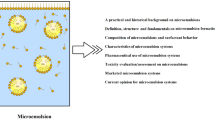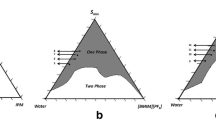Abstract
Microemulsions (μEs)-based drug delivery is known to be superior as well as effective due to customizable and easy management, efficiency and capability, and quick drug absorption over a wide range of targets. Herein, two μE formulations were established comprising of clove oil (as oil phase), water (as aqueous phase), Tween-80 (as surfactant), isopropanol, and methanol (as cosurfactant) for formulation A (μE-A) and formulation B (μE-B), respectively, and further used for the encapsulation of an antimuscarinic drug, mirabegron (MBG). Multiple complementary measurements, namely, electrical conductivity (σ), viscosity (η), and optical microscopy, show the existence of phase transition from W/O to O/W μE via intermediate bicontinuous channels. MBG showed long storage stability as well as good solubility i.e. 3.0 and 2.5 wt% at pH 6.4 in optimum μE-A and μE-B, respectively. Furthermore, no apparent aggregation of MBG was observed, as revealed by scanning transmission electron microscopy and peak correlations of IR analysis, suggesting the stability of MBG inside the formulations. Likewise, fluorescence detection senses the interfacial environment of MBG molecules in the examined formulations that could be vital for understanding the mechanism of controlled drug release.

Structural Dynamics of Tween-Based Microemulsions for Antimuscarinic Drug Mirabegron






Similar content being viewed by others
References
Abbaspourrad A, Datta SS, Weitz DA (2013) Controlling release from pH-responsive microcapsules. Langmuir 29(41):12697–12702
Chen Y, Liu L (2012) Modern methods for delivery of drugs across the blood–brain barrier. Adv Drug Deliv Rev 64(7):640–665
Negrini R, Mezzenga R (2011) pH-responsive lyotropic liquid crystals for controlled drug delivery. Langmuir 27(9):5296–5303
Tourné-Péteilh C, Coasne B, in M, Brevet D, Devoisselle JM, Vioux A, Viau L (2014) Surfactant behavior of ionic liquids involving a drug: from molecular interactions to self-assembly. Langmuir 30(5):1229–1238
Wang J, Wang Y, Liang W (2012) Delivery of drugs to cell membranes by encapsulation in PEG-PE micelles. J Control Release 160(3):637–651
Xiong W et al (2015) A novel capsule-based self-recovery system with a chloride ion trigger. Sci Rep 5(1):10866–10866
Zahr AS et al (2005) Encapsulation of drug nanoparticles in self-assembled macromolecular nanoshells. Langmuir 21(1):403–410
Nazar MF, Saleem MA, Bajwa SN, Yameen B, Ashfaq M, Zafar MN, Zubair M (2017) Encapsulation of antibiotic levofloxacin in biocompatible microemulsion formulation: insights from microstructure analysis. J Phys Chem B 121(2):437–443
Acharya DP, Hartley PG (2012) Progress in microemulsion characterization. Curr Opin Colloid Interface Sci 17(5):274–280
Panapisal V, Charoensri S, Tantituvanont A (2012) Formulation of microemulsion systems for dermal delivery of silymarin. AAPS PharmSciTech 13(2):389–399
Thatai PS, B. (2017) Transungual gel of terbinafine hydrochloride for the management of onychomycosis: formulation, optimization, and evaluation. AAPS PharmSciTech 18(6):2316–2328
Aggarwal N, Goindi S, Khurana R (2013) Formulation, characterization and evaluation of an optimized microemulsion formulation of griseofulvin for topical application. Colloids Surf B: Biointerfaces 105:158–166
Larsen SW et al (2013) Use of in vitro release models in the design of sustained and localized drug delivery systems for subcutaneous and intra-articular administration. J Drug Deliv Sci Technol 23(4):315–324
Spernath A, Aserin A (2006) Microemulsions as carriers for drugs and nutraceuticals. Adv Colloid Interf Sci 128-130:47–64
Shah AP, Yashwant, et al. (2016) Ophthalmic drug delivery systems for the treatment of corneal diseases. Syst Rev Pharm 1(2):583–592
Nazar MF, Khan AM, Shah SS (2009) Microemulsion system with improved loading of piroxicam: a study of microstructure. AAPS PharmSciTech 10(4):1286–1294
Nazar MF, Yasir Siddique M, Saleem MA, Zafar M, Nawaz F, Ashfaq M, Khan AM, Abd Ur Rahman HM, Tahir MB, Mat Lazim A (2018) Fourth-generation antibiotic gatifloxacin encapsulated by microemulsions: structural and probing dynamics. Langmuir 34(36):10603–10612
Szumała P (2015) Structure of microemulsion formulated with monoacylglycerols in the presence of polyols and ethanol. J Surfactant Deterg 18:97–106
Klossek ML, Marcus J, Touraud D, Kunz W (2013) The extension of microemulsion regions by combining ethanol with other cosurfactants. Colloids Surfactant A 427:95–100
Deng L, Taxipalati M, Sun P, Que F, Zhang H (2015) Phase behavior, microstructural transition, antimicrobial and antioxidant activities of a water-dilutable thymol microemulsion. Colloids Surf B: Biointerfaces 136:859–866
Kaur G, Mehta SK (2014) Probing location of anti-TB drugs loaded in Brij 96 microemulsions using thermoanalytical and photophysical approach. J Pharm Sci 103(3):937–944
Metwally AA, Hathout RM (2015) Replacing microemulsion formulations experimental solubility studies with in-silico methods comprising molecular dynamics and docking experiments. Chem Eng Res Des 104:453–456
Shevachman MGN, Shani A, Sintov AC (2008) Enhanced percutaneous permeability of diclofenac using a new U-type dilutable microemulsion. Drug Dev Ind Pharm 34(4):403–412
Singh D et al (2016) Topical drug delivery systems: a patent review. Expert Opin Ther Patents 26(2):213–228
Subramanian N et al (2006) Formulation and physicochemical characterization of microemulsion system using isopropyl myristate, medium-chain glyceride, polysorbate 80 and water. Chem Pharm Bull 53(12):1530–1535
Zadymova NMP, M.V. (2019) Microemulsions and microheterogeneous microemulsion-based polymeric matrices for transdermal delivery of lipophilic drug (Felodipine). Colloid Polym Sci 297(3):453–468
Lawrence MJ, Rees GD (2000) Microemulsion-based media as novel drug delivery systems. Adv Drug Deliv Rev 45:89–121
Kalam MA, Alshamsan A, Aljuffali IA, Mishra AK, Sultana Y (2016) Delivery of gatifloxacin using microemulsion as vehicle: formulation, evaluation, transcorneal permeation and aqueous humor drug determination. Drug Deliv 23:896–907
Gras J (2012) Mirabegron for the treatment of overactive bladder. Drugs Today 48(1):25–32
Yoshida T, Yoshioka Y, Takahashi H, Misato K, Mori T, Hirai T, Nagano K, Abe Y, Mukai Y, Kamada H, Tsunoda S, Nabeshi H, Yoshikawa T, Higashisaka K, Tsutsumi Y (2014) Intestinal absorption and biological effects of orally administered amorphous silica particles. Nanoscale Res Lett 9(1):532
Zhang X-X et al (2008) Effects of breast cancer resistance protein inhibitors and pharmaceutical excipients on decreasing gastrointestinal toxicity of camptothecin analogs. Acta Pharm Sin B 29(11):1391–1398
Callender SP et al (2017) Microemulsion utility in pharmaceuticals: implications for multi-drug delivery. Int J Pharm 526(1):425–442
Malik M et al (2006) Lethal fragmentation of bacterial chromosomes mediated by DNA gyrase and quinolones. J Mol Biol 61(3):810–825
Ibrahim HK et al (2010) Mucoadhesive nanoparticles as carrier systems for prolonged ocular delivery of gatifloxacin/prednisolone bitherapy. J Mol Med 7(2):576–585
Rajinikanth PS, Mishra JBB (2007) Development and evaluation of a novel floating in situ gelling system of amoxicillin for eradication of helicobacter pylori. Int J Pharm 335(1–2):114–122
Aloisio C, G de Oliveira A, Longhi M (2016) Cyclodextrin and meglumine-based microemulsions as a poorly water-soluble drug delivery system. J Pharm Sci 105(9):2703–2711
Bardhan S, Kundu K, Saha SK, Paul BK (2013) Physicochemical studies of mixed surfactant microemulsions with isopropyl myristate as oil. J Colloid Interface Sci 402:180–189
Patel MRP, R. B., Parikh JR, Patel BG (2016) Formulation consideration and skin retention study of microemulsion containing tazarotene for targeted therapy of acne. J Pharm Investig 46(1):55–66
Zhu A et al (2007) O-Carboxymethylchitosan-based novel gatifloxacin delivery system. Carbohydr Polym 68(4):693–700
Aliberti ALM d QAC, Praça FSG, Eloy JO, Bentley MVLB, Medina WSG (2017) Ketoprofen microemulsion for improved skin delivery and in vivo anti-inflammatory effect. AAPS PharmSciTech 18(7):2783–2791
Sari TPMB, Kumar R, Singh RRB, Sharma R, Bhardwaj M, Athira S (2015) Preparation and characterization of nanoemulsion encapsulating curcumin. Food Hydrocoll 43:540–546
Bermejo R, Tobaruela DJ, Talavera EM, Orte A, Alvarez-Pez JM (2003) Fluorescent behavior of B-phycoerythrin in microemulsions of aerosol OT/water/isooctane. J Colloid Interface Sci 263(2):616–624
Pople PV, Singh KK (2010) Targeting tacrolimus to deeper layers of skin with improved safety for treatment of atopic dermatitis. Int J Pharm 398:165–178
Patel RB, Patel MR, Bhatt KK, Patel BG (2013) Risperidone loaded mucoadhesive microemulsion for intranasal delivery: formulation, development, physicochemical characterization and ex vivo evaluation. J Drug Deli Sci Technol 23:561–567
Zhu X et al (2008) Fluorescence probe enhanced spectrorimetric method for the determination of gatifloxacin in pharmaceutical formulations and biological fluids. Spectrochim Acta A Mol Biomol Spectrosc 69(2):478–482
Ujjwal NJMA, Imran K, Afzal M, Firoz A (2012) Preparation ana evaluation of antifungal micro-emulsion gel/ using reduce dose of silver, supported by Ciorofloxacin. Int J Pharm Investig 2(1):1–16
Ustundag-Okur NGEH, Ehrilmez SO, Ertan G (2014) Novel Ofloxacin-loaded microemulsion formulations for ocular Delievry. J Ocul Pharmacol Ther 30(4):319–332
Vedantham R et al (2015) Practical synthesis of Mirabegron. J Chem Pharm Res 7(4):1473–1478
Theochari I et al (2017) Drug nanocarriers for cancer chemotherapy based on microemulsions: the case of Vemurafenib analog PLX4720. Colloids Surf B: Biointerfaces 154(1):350–356
Tiwari G, Tiwari R, Bannerjee S, Bhati L, Pandey S, Pandey P, Sriwastawa B (2012) Drug delivery systems: an updated review. Int J Pharm Investig 2(1):2–11
Sudheer P et al (2013) Microemulsion–a versatile dimension of novel drug delivery system. Int J Pharm Sci Rev Res 20(2):138–148
Syamasri Gupta SPM (2008) Biocompatible microemulsions and their prospective uses in drug delivery. J Pharm Sci 97(1):22–45
Sabale V, Vora S (2012) Formulation and evaluation of microemulsion-based hydrogel for topical delivery. Int J Pharm 2(3):140–149
Sahu GSH, Gupta A, Kaur C (2015) Advancement in microemulsion based drug delivery system for better therapeutic effects. AAPS PharmSci Tech 1:8–15
Shaaban H, El-Ghorab A (2012) Bioactivity of essential oils and their volatile aroma components: review. J Essent Oil Res 24(2):203–212
Erdal MS, Özhan G, Mat MC, Özsoy Y, GüngÖr S (2016) Colloidal nanocarriers for the enhanced cutaneous delivery of naftifine: characterization studies and in vitro and in vivo evaluations. Int J Nanomed 11:1027–1037
Lin CC, Lin HY, Chi MH, Shen CM, Chen HW, Yang WJ, Lee MH (2014) Preparation of Curcumin microemulsions with food-grade soybean oil/lecithin and their cytotoxicity on the HepG2 cell line. Food Chem 154:282–290
Acknowledgements
The authors express their gratitude to the Department of Chemistry, University of Gujrat Pakistan for providing laboratory facilities.
Funding
M.F. Nazar also extends his thanks to Higher Education Commission of Pakistan for providing financial support through NRPU Project. 20–4557/NRPU/R&D/HEC/14/481.
Author information
Authors and Affiliations
Corresponding author
Ethics declarations
Conflict of interest
The authors declare that they have no conflict of interest.
Additional information
Publisher’s note
Springer Nature remains neutral with regard to jurisdictional claims in published maps and institutional affiliations.
Electronic supplementary material
ESM 1
(DOCX 8703 kb)
Rights and permissions
About this article
Cite this article
Nazar, M.F., Mujeed, A., Siddique, M.Y. et al. Structural dynamics of tween-based microemulsions for antimuscarinic drug mirabegron. Colloid Polym Sci 298, 263–271 (2020). https://doi.org/10.1007/s00396-020-04603-w
Received:
Revised:
Accepted:
Published:
Issue Date:
DOI: https://doi.org/10.1007/s00396-020-04603-w




